Abdominal drainage to prevent intra-peritoneal abscess after appendectomy for complicated appendicitis
- PMID: 34402522
- PMCID: PMC8407456
- DOI: 10.1002/14651858.CD010168.pub4
Abdominal drainage to prevent intra-peritoneal abscess after appendectomy for complicated appendicitis
Update in
-
Abdominal drainage to prevent intraperitoneal abscess after appendectomy for complicated appendicitis.Cochrane Database Syst Rev. 2025 Apr 11;4(4):CD010168. doi: 10.1002/14651858.CD010168.pub5. Cochrane Database Syst Rev. 2025. PMID: 40214287
Abstract
Background: This is the second update of a Cochrane Review first published in 2015 and last updated in 2018. Appendectomy, the surgical removal of the appendix, is performed primarily for acute appendicitis. Patients who undergo appendectomy for complicated appendicitis, defined as gangrenous or perforated appendicitis, are more likely to suffer postoperative complications. The routine use of abdominal drainage to reduce postoperative complications after appendectomy for complicated appendicitis is controversial.
Objectives: To assess the safety and efficacy of abdominal drainage to prevent intraperitoneal abscess after appendectomy (irrespective of open or laparoscopic) for complicated appendicitis; to compare the effects of different types of surgical drains; and to evaluate the optimal time for drain removal.
Search methods: We searched the Cochrane Central Register of Controlled Trials (CENTRAL), Ovid MEDLINE, Ovid Embase, Web of Science, the World Health Organization International Trials Registry Platform, ClinicalTrials.gov, Chinese Biomedical Literature Database, and three trials registers on 24 February 2020, together with reference checking, citation searching, and contact with study authors to identify additional studies.
Selection criteria: We included all randomised controlled trials (RCTs) that compared abdominal drainage versus no drainage in people undergoing emergency open or laparoscopic appendectomy for complicated appendicitis. We also included RCTs that compared different types of drains and different schedules for drain removal in people undergoing appendectomy for complicated appendicitis.
Data collection and analysis: We used standard methodological procedures expected by Cochrane. Two review authors independently identified the trials for inclusion, collected the data, and assessed the risk of bias. We used the GRADE approach to assess evidence certainty. We included intraperitoneal abscess as the primary outcome. Secondary outcomes were wound infection, morbidity, mortality, hospital stay, hospital costs, pain, and quality of life.
Main results: Use of drain versus no drain We included six RCTs (521 participants) comparing abdominal drainage and no drainage in participants undergoing emergency open appendectomy for complicated appendicitis. The studies were conducted in North America, Asia, and Africa. The majority of participants had perforated appendicitis with local or general peritonitis. All participants received antibiotic regimens after open appendectomy. None of the trials was assessed as at low risk of bias. The evidence is very uncertain regarding the effects of abdominal drainage versus no drainage on intraperitoneal abscess at 30 days (risk ratio (RR) 1.23, 95% confidence interval (CI) 0.47 to 3.21; 5 RCTs; 453 participants; very low-certainty evidence) or wound infection at 30 days (RR 2.01, 95% CI 0.88 to 4.56; 5 RCTs; 478 participants; very low-certainty evidence). There were seven deaths in the drainage group (N = 183) compared to one in the no-drainage group (N = 180), equating to an increase in the risk of 30-day mortality from 0.6% to 2.7% (Peto odds ratio 4.88, 95% CI 1.18 to 20.09; 4 RCTs; 363 participants; low-certainty evidence). Abdominal drainage may increase 30-day overall complication rate (morbidity; RR 6.67, 95% CI 2.13 to 20.87; 1 RCT; 90 participants; low-certainty evidence) and hospital stay by 2.17 days (95% CI 1.76 to 2.58; 3 RCTs; 298 participants; low-certainty evidence) compared to no drainage. The outcomes hospital costs, pain, and quality of life were not reported in any of the included studies. There were no RCTs comparing the use of drain versus no drain in participants undergoing emergency laparoscopic appendectomy for complicated appendicitis. Open drain versus closed drain There were no RCTs comparing open drain versus closed drain for complicated appendicitis. Early versus late drain removal There were no RCTs comparing early versus late drain removal for complicated appendicitis.
Authors' conclusions: The certainty of the currently available evidence is low to very low. The effect of abdominal drainage on the prevention of intraperitoneal abscess or wound infection after open appendectomy is uncertain for patients with complicated appendicitis. The increased rates for overall complication rate and hospital stay for the drainage group compared to the no-drainage group are based on low-certainty evidence. Consequently, there is no evidence for any clinical improvement with the use of abdominal drainage in patients undergoing open appendectomy for complicated appendicitis. The increased risk of mortality with drainage comes from eight deaths observed in just under 400 recruited participants. Larger studies are needed to more reliably determine the effects of drainage on morbidity and mortality outcomes.
Copyright © 2021 The Cochrane Collaboration. Published by John Wiley & Sons, Ltd.
Conflict of interest statement
Li Zhuyin: None known
Li Zhe: None known
Zhao L: None known
Cheng Y: None known
Cheng N: None known
Deng Y: None known
Figures

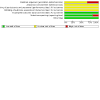
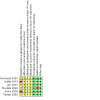
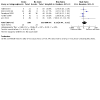

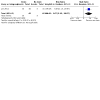
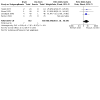
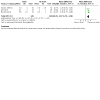
Update of
-
Abdominal drainage to prevent intra-peritoneal abscess after open appendectomy for complicated appendicitis.Cochrane Database Syst Rev. 2018 May 9;5(5):CD010168. doi: 10.1002/14651858.CD010168.pub3. Cochrane Database Syst Rev. 2018. Update in: Cochrane Database Syst Rev. 2021 Aug 17;8:CD010168. doi: 10.1002/14651858.CD010168.pub4. PMID: 29741752 Free PMC article. Updated.
References
References to studies included in this review
Dandapat 1992 {published data only}
-
- Dandapat MC, Panda C. A perforated appendix: should we drain? Journal of the Indian Medical Association 1992;90(6):147-8. - PubMed
Haller 1973 {published data only}
Jani 2011 {published data only}
-
- Jani PG, Nyaga PN. Peritoneal drains in perforated appendicitis without peritonitis: a prospective randomized controlled study. East and Central African Journal of Surgery 2011;16(2):62-71.
Mustafa 2016 {published data only}
-
- Mustafa MIT, Chaudhry SM, Mustafa RIT. Comparison of early outcome between patients of open appendectomy with and without drain for perforated appendicitis. Pakistan Journal of Medical and Health Sciences 2016;10(3):890-3.
Stone 1978 {published data only}
References to studies excluded from this review
Abdulhamid 2018 {published data only}
Allemann 2011 {published data only}
Al‐Shahwany 2012 {published data only}
-
- Al-Shahwany IW, Hindoosh LN, Rassam R, Al-Qadhi A. Drain or not to drain in appendectomy for perforated appendicitis. Iraqi Postgraduate Medical Journal 2012;11(3):349-52.
Beek 2015 {published data only}
Everson 1977 {published data only}
Ezer 2010 {published data only}
Fujishiro 2020 {published data only}
Greenall 1978 {published data only}
Johnson 1993 {published data only}
-
- Johnson DA, Kosloske AM, Macarthur C. Perforated appendicitis in children: to drain or not to drain? Pediatric Surgery International 1993;8(5):402-5. [DOI: 10.1007/BF00176728] - DOI
Magarey 1971 {published data only}
Miranda‐Rosales 2019 {published data only}
-
- Miranda-Rosales LM, Kcam-Mayorca EJ, Luna-Abanto J, Malpartida-Saavedra H, Flores-Flores C. Use of drains and post-operative complications in secondary peritonitis for complicated acute appendicitis at a national hospital. Cirugía Cirujanos 2019;87(5):540-4. [DOI: 10.24875/CIRU.19000713] - DOI - PubMed
Narci 2007 {published data only}
Piper 2011 {published data only}
Song 2015 {published data only}
References to studies awaiting assessment
Afzal 2017 {published data only}
-
- Afzal S, Hussain I, Khan AZ, Ashraf MK. Comparison of early outcome between patients of open appendectomy with and without drain for perforated appendicitis. Journal of Fatima Jinnah Medical University 2017;11(1):20-3.
Additional references
Andersen 2005
Anderson 2014
Andreu‐Ballester 2009
Ban 2017
Berríos‐Torres 2017
Boomer 2010
Buckius 2012
Ceresoli 2016
Chandler 2020
-
- Chandler J, Lasserson T, Higgins JPT, Tovey D, Thomas J, Flemyng E, et al. Standards for the planning, conduct and reporting of updates of Cochrane Intervention Reviews. In: Higgins JPT, Lasserson T, Chandler J, Tovey D, Thomas J, Flemyng E, Churchill R. Methodological Expectations of Cochrane Intervention Reviews. Cochrane: London, Version March 2020.
Charoenkwan 2017
-
- Charoenkwan K, Kietpeerakool C. Retroperitoneal drainage versus no drainage after pelvic lymphadenectomy for the prevention of lymphocyst formation in women with gynaecological malignancies. Cochrane Database of Systematic Reviews 2017, Issue 6. Art. No: CD007387. [DOI: 10.1002/14651858.CD007387.pub4] - DOI - PMC - PubMed
Cheng 2012a
Cheng 2017
Clavien 2009
Coward 2016
-
- Coward S, Kareemi H, Clement F, Zimmer S, Dixon E, Ball CG, et al. Incidence of appendicitis over time: a comparative analysis of an administrative healthcare database and a pathology-proven appendicitis registry. PLOS ONE 2016;11(11):e0165161. [DOI: 10.1371/journal.pone.0165161] - DOI - PMC - PubMed
Cueto 2006
Danwang 2020
Deeks 2021
-
- Deeks JJ, Higgins JPT, Altman DG, editor(s). Chapter 10: Analysing data and undertaking meta-analyses. In: Higgins JP, Thomas J, Chandler J, Cumpston M, Li T, Page MJ, Welch VA, editor(s). Cochrane Handbook for Systematic Reviews of Interventions Version 6.2 (updated February 2021). Cochrane, 2021. Available from training.cochrane.org/handbook.
Doleman 2018
-
- Doleman B, Sutton AJ, Sherwin M, Lund JN, Williams JP. Baseline morphine consumption may explain between-study heterogeneity in meta-analyses of adjuvant analgesics and improve precision and accuracy of effect estimates. Anesthesia and Analgesia 2018;126(2):648-60. - PubMed
Doleman 2020
-
- Doleman B, Freeman SC, Lund JN, Williams JP, Sutton AJ. Funnel plots may show asymmetry in the absence of publication bias with continuous outcomes dependent on baseline risk: presentation of a new publication bias test. Research Synthesis Methods 2020;11(4):522-34. - PubMed
Durai 2009
-
- Durai R, Mownah A, Ng PC. Use of drains in surgery: a review. Journal of Perioperative Practice 2009;19(6):180-6. - PubMed
Duttaroy 2009
Endnote X7 [Computer program]
-
- Endnote. Version X7. Clarivate, 2013.
Ferris 2017
Gates 2013
Golz 2020
Gurusamy 2007a
Gurusamy 2007b
Gurusamy 2013
Hall 2010
Higgins 2017
-
- Higgins JP, Altman DG, Sterne JA, editor(s). Chapter 8: Assessing risk of bias in included studies. In: Higgins JPT, Churchill R, Chandler J, Cumpston MS, editor(s). Cochrane Handbook for Systematic Reviews of Interventions version 5.2.0 (updated June 2017). Cochrane, 2017. Available from training.cochrane.org/handbook/archive/v5.2.
Higgins 2021
-
- Higgins JP, Thomas J, Chandler J, Cumpston M, Li T, Page MJ, Welch VA, editor(s). Cochrane Handbook for Systematic Reviews of Interventions Version 6.2 (updated February 2021). Cochrane, 2021. Available from training.cochrane.org/handbook. - PMC - PubMed
Jaschinski 2018
Lee 2010
Lefebvre 2021
-
- Lefebvre C, Glanville J, Briscoe S, Littlewood A, Marshall C, Metzendorf M-I, et al. Chapter 4: Searching for and selecting studies. In: Higgins JP, Thomas J, Chandler J, Cumpston M, Li T, Page MJ, Welch VA, editor(s). Cochrane Handbook for Systematic Reviews of Interventions Version 6.2 (updated February 2021). Cochrane, 2021. Available from training.cochrane.org/handbook.
Livingston 2007
Murakami 2019
Oliak 2000
Parker 2007
Petrowsky 2004
Reeves 2021
-
- Reeves BC, Deeks JJ, Higgins JPT, Shea B, Tugwell P, Wells GA. Chapter 24: Including non-randomized studies on intervention effects. In: Higgins JP, Thomas J, Chandler J, Cumpston M, Li T, Page MJ, Welch VA, editor(s). Cochrane Handbook for Systematic Reviews of Interventions Version 6.2 (updated February 2021). Cochrane, 2021. Available from training.cochrane.org/handbook.
Rehman 2011
Review Manager 2020 [Computer program]
-
- Nordic Cochrane Centre, The Cochrane Collaboration Review Manager 5 (RevMan 5). Version 5.4. Copenhagen: Nordic Cochrane Centre, The Cochrane Collaboration, 2020.
Rolph 2004
-
- Rolph R, Duffy JMN, Alagaratnam S, Ng P, Novell R. Intra-abdominal drains for the prophylaxis of anastomotic leak in elective colorectal surgery. Cochrane Database of Systematic Reviews 2004, Issue 4. Art. No: CD002100. [DOI: 10.1002/14651858.CD002100.pub2] - DOI
Samraj 2007
Santacroce 2019
-
- Santacroce L, Geibel J, Ochoa JB, Hines OJ, Talavera F. Appendectomy. emedicine.medscape.com/article/195778-overview (accessed 24 February 2020).
Schünemann 2021
-
- Schünemann HJ, Higgins JPT, Vist GE, Glasziou P, Akl EA, Skoetz N, Guyatt GH. Chapter 14: Completing ‘Summary of findings’ tables and grading the certainty of the evidence. In: Higgins JPT, Thomas J, Chandler J, Cumpston M, Li T, Page MJ, Welch VA (editors). Cochrane Handbook for Systematic Reviews of Interventions version 6.2 (updated February 2021). Cochrane, 2021. Available from www.training.cochrane.org/handbook.
Simillis 2010
Sterne 2017
-
- Sterne JA, Egger M, Moher D, Boutron I, editor(s). Chapter 10: Addressing reporting biases. In: Higgins JPT, Churchill R, Chandler J, Cumpston MS, editor(s). Cochrane Handbook for Systematic Reviews of Interventions version 5.2.0 (updated June 2017). Cochrane, 2017. Available from training.cochrane.org/handbook/archive/v5.2.
Wang 2015
Wilms 2011
Yu 2017
References to other published versions of this review
Cheng 2012b
Cheng 2015
Publication types
MeSH terms
LinkOut - more resources
Full Text Sources
Medical

